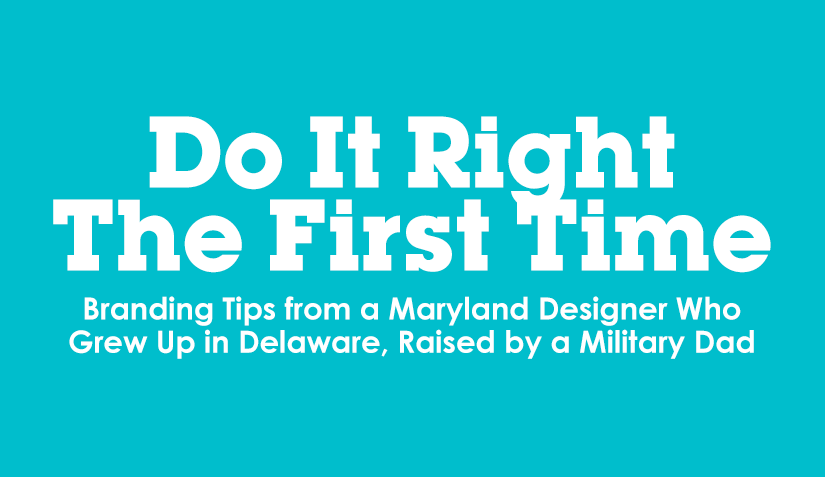Do It Right The First Time
Branding Tips from a Maryland Designer Who Grew Up in Delaware, Raised by a Military Dad
by Meredith S. K. Boas
Owner of Grunge Muffin Designs
My father is an E-7 Master Sergeant in the Air Force, entering his 32nd year of service, and who spent his first twenty-three years in the Navy. Throughout my life he has used a lot of “dad” catchphrases such as “Do it right the first time, so you don’t have to do it again” that have sculpted my personal work ethic, and shaped the way I look at projects. Over the six years I’ve owned my business I’ve had clients come across my path, who generally belong to one of three categories:
1. The Planner.
This type of client has a business plan in place and has their business registered. They’re ready to secure their website domain name, have a logo designed and trademarked, get small design items created so they can start networking, etc. They believe in the design process and they are seeking a professional to guide them.
2. The Do-It Myselfer.
This type of client feels confident in forging ahead and putting something workable together by themself, be it a logo, a website, business cards, etc. It might not be pretty but it’s functional. Typically this type of client comes across my path after they’ve been in business for a year or two and have saved up for professional branding.
3. The Mess.
This type of client has typically been in business for many years. They have inconsistent, mismatched marketing materials that sometimes look outdated with multiple logo variations. They may have relied on friends or family to create designs for them. This type is often more skiddish about setting up their brand professionally because they think “If it ain’t broke don’t fix it”.
Regardless of whatever category you fall into – don’t feel bad! Ideally you’d be a planner from the outset – but the important thing is to connect with a designer and formulate a brand strategy with a budget in mind for each year. It’s never too late to get things “ship shape”.
When you do connect with a designer, I want you to protect yourself and have autonomy from your graphic designer or web developer. I don’t want you to feel stuck or beholden to someone. So let’s get started. These 7 tips are important to getting your business branding started in a way that benefits you and your wallet.
1. Get a Logo – Trademark It
Most designers will only create 1 logo mockup based on the information you give them, so you need to be clear about what you want to see. Provide the exact wording (business name, slogan, etc), the colors, any specific icon or illustration. Give reference images to other logos or brands you like.
Once you have the logo – trademark it. You can either file the application yourself with the trademark office OR hire a lawyer to handle the application for you (trademark lawyers usually have a package deal – ask me about it).
Trademarking will legally give you the ability to stop other businesses from encroaching on your visual business identity.
2. Buy Your Domain Name
This is usually $12 a year. I recommend going to www.GoDaddy.com. You want to get your domain name from the same place you’ll be getting your website hosting because it takes 60 DAYS to transfer a domain name from one place to another. Your domain name is free for the first year if you buy hosting BUT don’t get hosting until you’re ready to have the site built, otherwise you’re just wasting money.
3. Cover the Basics – Get Designs
With your new logo in hand, and website underway, start getting other items together that you will need to network with. Get your business cards, a tri-fold with your services laid out, a nice name badge, etc. What are your competitors using? Zero in on the things you need to best represent yourself.
4. Get Social Media
DO NOT feel like you need to be represented on every social media platform. Pick one or two that you’re going to actively learn and use. Not all social media sites are good for every type of business. Instagram for example is a visual platform, it’s all about pictures. Youtube is also visual, but caters more to videos. Facebook is a good option for writing posts, getting reviews, sharing events, and joining groups. So decide which ones you’ll actively enjoy using.
5. Buy A Website Hosting Plan
Get hosting yourself from somewhere like www.GoDaddy.com that way you have access to your billing and your site. Be weary of having your site built on a private server by a web developer. If the business relationship goes south, will they give you access to your site?
6. Get Your Website Up
When it’s time to build the site – make it a WordPress site. Not Weebly, not Wix. WordPress is a FREE application that can be installed on your website. You then want to install a purchased theme that has a ton of advanced functionality. I recommend having a designer/developer that’s fluent in WordPress set it up for you. WordPress will give you, the client, the option to maintain your own site if that’s important to you.
Your job should be to focus on gathering website content – the wording and images that need to go on your site. Write it out in detail because your designer will use that content to populate the site. Your website should not feel like an annoying chore – it is a place to direct your potential clients who want more information about you.
7. Connect With Community
Get out there! Join at least one networking group, and start getting to know other business owners in your area. Refer one another!
Read more articles from VOM Magazine here: https://www.veteransoutreachministries.org/vom-magazine/




